
Reviewed by
Beck Jinnette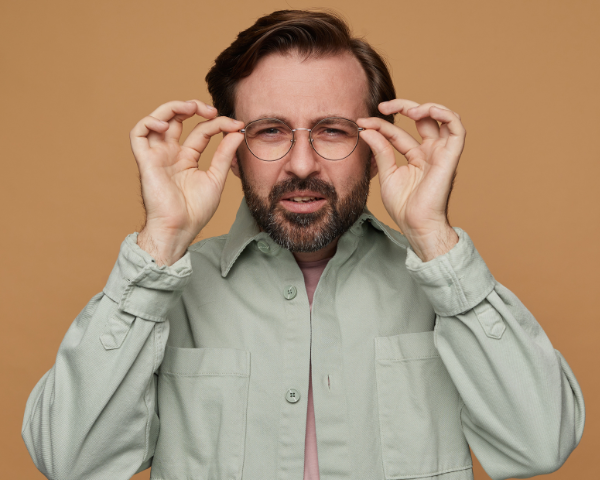
What is myopia?
Also known as nearsightedness or shortsightedness, myopia is a condition that impairs distance vision, reducing visual acuity and making objects appear fuzzy. Sufferers of myopia can generally see clearly in their near field of vision, but experience blurry vision when looking at distant objects.
Myopia is the number one cause of impaired vision in people under age 40, and its prevalence is rising.
The World Health Organisation estimated that 2.2 billion people were affected by myopia in 2019. By 2050, half of the world’s population is expected to be myopic (Nouraeinejad, 2021). Untreated myopia can be a risk factor for developing cataracts, glaucoma and retinal detachment, posing a considerable risk to eye health.
Myopia is a very common condition and, thankfully, is very easily treatable. It is important to get your eyes tested regularly in order to promptly receive treatment if and when needed.
Also known as nearsightedness or shortsightedness, myopia is a condition that impairs distance vision, reducing visual acuity and making objects appear fuzzy.
Sufferers of myopia can generally see clearly in their near field of vision, but experience blurry vision when looking at distant objects.
Myopia is the number one cause of impaired vision in people under age 40, and its prevalence is rising.
The World Health Organisation estimated that 2.2 billion people were affected by myopia in 2019. By 2050, half of the world’s population is expected to be myopic (Nouraeinejad, 2021).
Untreated myopia can be a risk factor for developing cataracts, glaucoma and retinal detachment, posing a considerable risk to eye health.
Myopia is a very common condition and, thankfully, is very easily treatable. It is important to get your eyes tested regularly in order to promptly receive treatment if and when needed.
What causes myopia?
Myopia is a refractive error, meaning that there is a problem with the way light rays are bent when entering the eye. Refractive errors are the most common vision problems, and myopia is the most common of them all. There are a couple of causes of this particular refractive error, the most common being related to the shape of the eyeball itself.
When the eyeball is elongated, light is focused in front of the retina, rather than directly on it, causing blurry vision. An irregularly-shaped cornea can also be responsible for myopia. When the curvature of the cornea is too high, it creates the same issue of the light rays focusing in front of the retina.
Myopia is a refractive error, meaning that there is a problem with the way light rays are bent when entering the eye.
Refractive errors are the most common vision problems, and myopia is the most common of them all.
There are a couple of causes of this particular refractive error, the most common being related to the shape of the eyeball itself.
When the eyeball is elongated, light is focused in front of the retina, rather than directly on it, causing blurry vision.
An irregularly-shaped cornea can also be responsible for myopia.
When the curvature of the cornea is too high, it creates the same issue of the light rays focusing in front of the retina.
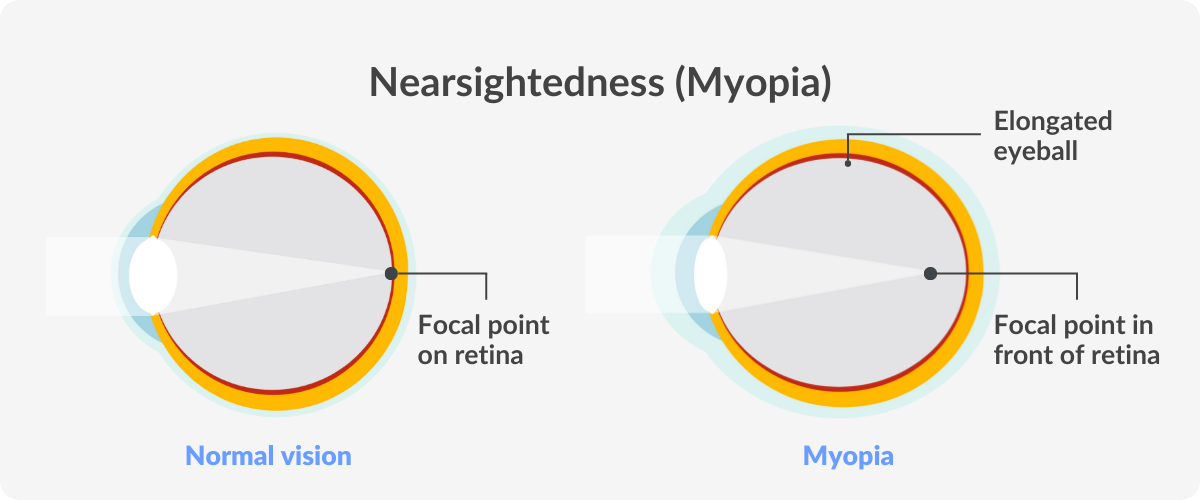
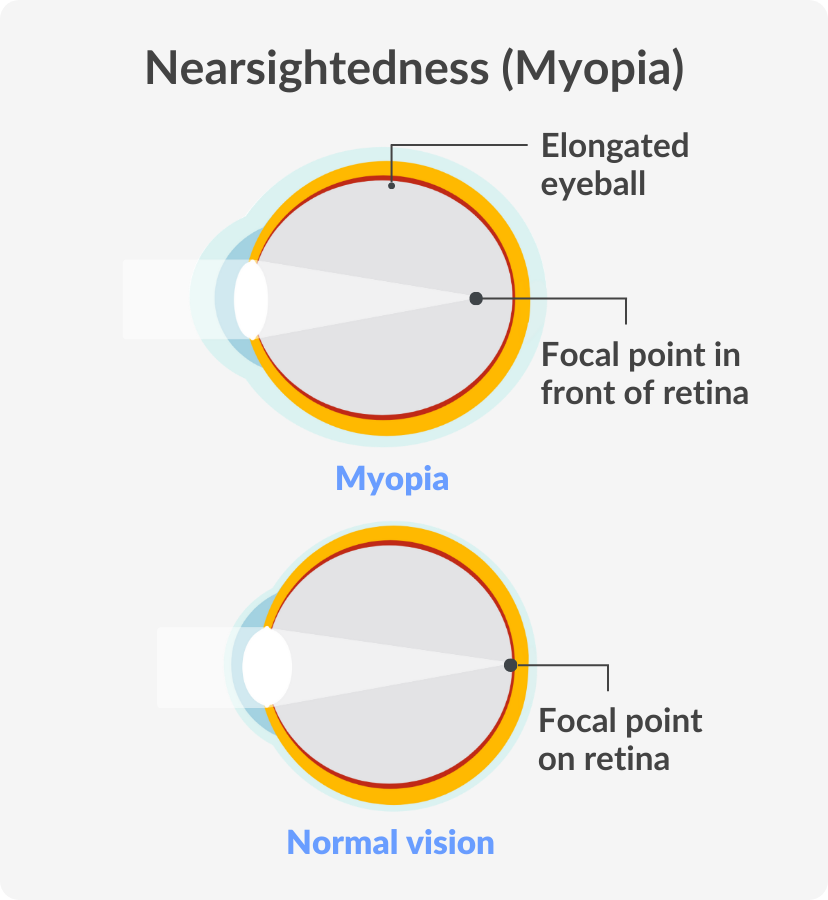
Myopia is one of many genetic eye conditions, so if one or both of your parents have it, they will likely pass it on to you. Children typically develop myopia between the ages of 6 and 14. The blurred vision it creates can continue to worsen until around 40, but it usually levels off by the age of 20.
Myopia is one of many genetic eye conditions, so if one or both of your parents have it, they will likely pass it on to you. Children typically develop myopia between the ages of 6 and 14.
The blurred vision it creates can continue to worsen until around 40, but it usually levels off by the age of 20.
Myopia symptoms
There are several common symptoms that can indicate the presence of myopia:
- Regular headaches
- Frequent rubbing of eyes
- Squinting when trying to focus on distant objects
- Tiredness when playing sports or driving
As myopia most commonly develops during childhood, having difficulty reading what’s written on the board at school is often the first telltale sign in children. This may affect the quality of their grades, which can be another indicator for parents, as can holding objects close to their faces.
Children can be reluctant to wear glasses and, therefore, may be unwilling to talk to their parents about their vision problems. If you notice any of the above behaviours in your child, approach the topic with them delicately, and book an eye test with your local optometrist.
There are several common symptoms that can indicate the presence of myopia:
- Regular headaches
- Frequent rubbing of eyes
- Squinting when trying to focus on distant objects
- Tiredness when playing sports or driving
As myopia most commonly develops during childhood, having difficulty reading what’s written on the board at school is often the first telltale sign in children.
This may affect the quality of their grades, which can be another indicator for parents, as can holding objects close to their faces.
Children can be reluctant to wear glasses and, therefore, may be unwilling to talk to their parents about their vision problems.
If you notice any of the above behaviours in your child, approach the topic with them delicately, and book an eye test with your local optometrist.
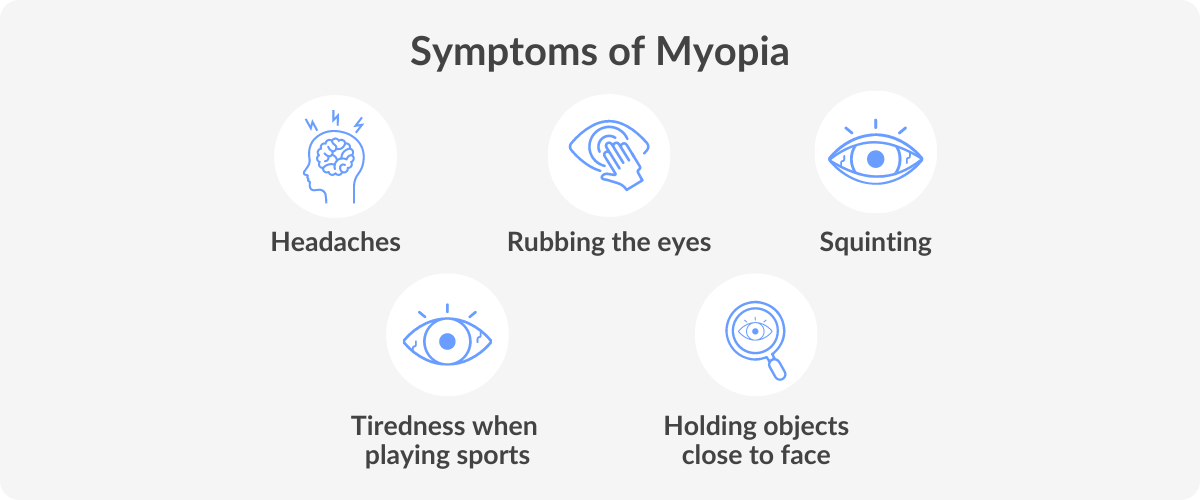

Myopia is genetic, so pay extra attention to your children if you are nearsighted. Children commonly develop myopia between 8 and 12 years old and during the teenage years the level of myopia can actually worsen as the body grows rapidly. Myopia normally stabilizes when people are between 20 and 40 years old.
Myopia is genetic, so pay extra attention to your children if you are nearsighted. Children commonly develop myopia between 8 and 12 years old.
During the teenage years the level of myopia can actually worsen as the body grows rapidly. Myopia normally stabilizes when people are between 20 and 40 years old.
High myopia
High myopia is a rare inherited type of severe nearsightedness, caused by an over-elongated eyeball or an overly-curved cornea. A refractive error greater than -6 is considered high myopia. The condition can continue to progress into a person’s 20s, but can be treated the same way as regular myopia, with corrective lenses or laser eye surgery.
However, it still poses a number of risks to eye health. A child with high myopia may be at greater risk of developing more serious eye problems later in life, such as glaucoma and cataracts.
People with high myopia are five to six times more likely to develop retinal detachment than those with low myopia, and it can even lead to blindness if not treated. Regular eye exams are essential to ensure that high myopia is identified and treated accordingly.
High myopia is a rare inherited type of severe nearsightedness, caused by an over-elongated eyeball or an overly-curved cornea. A refractive error greater than -6 is considered high myopia.
The condition can continue to progress into a person’s 20s, but can be treated the same way as regular myopia, with corrective lenses or laser eye surgery.
However, it still poses a number of risks to eye health. A child with high myopia may be at greater risk of developing more serious eye problems
later in life, such as glaucoma and cataracts.
People with high myopia are five to six times more likely to develop retinal detachment than those with low myopia, and it can even lead to blindness if not treated.
Regular eye exams are essential to ensure that high myopia is identified and treated accordingly.
Degenerative myopia
Degenerative myopia is also known as pathological myopia or progressive myopia. As this last name suggests, this severe myopia progresses further than other types of myopia. It damages parts of the eye, including the macula and the retina, and is a leading cause of legal blindness.
Myopia currently affects about 33% of people worldwide, with 50% of the world’s population on track to be myopic by 2050.
Degenerative myopia is also known as pathological myopia or progressive myopia.
As this last name suggests, this severe myopia progresses further than other types of myopia.
It damages parts of the eye, including the macula and the retina, and is a leading cause of legal blindness.
Myopia currently affects about 33% of people worldwide, with 50% of the world’s population on track to be myopic by 2050.

DID YOU KNOW?
Myopia has been becoming increasingly common for years. If the current rate of progressin continues, it is estimated that 50% of the world’s population will have some form of myopia by 2050.
Myopia treatment
Myopia is easily treated. The first step is to consult an optometrist for a comprehensive eye exam and an eye test. Corrective lenses are the most common method of myopia treatment, either in the form of glasses or contact lenses. Surgical procedures can provide a more permanent solution to the problem, but may not be suitable for everyone.
Myopia is easily treated. The first step is to consult an optometrist for a comprehensive eye exam and an eye test.
Corrective lenses are the most common method of myopia treatment, either in the form of glasses or contact lenses.
Surgical procedures can provide a more permanent solution to the problem, but may not be suitable for everyone.
Corrective lenses
Corrective lenses are the easiest and most often prescribed treatment for myopia. The eye doctor conducts an eye test and exam to diagnose the condition and calculate the lens prescription needed. The prescription is then applied to glasses lenses or contact lenses, which correct the refractive error and focus light directly on the retina, meaning no more blurry vision.
For most people, glasses are the easier and more comfortable option. Single vision lenses are usually used to treat myopia, but there are many types of lenses available, so you can speak with your optometrist to help you decide which option is best for you.
Contact lenses can provide greater peripheral vision and are particularly useful for playing sports and other outdoor activities, but some people find them uncomfortable. Many people use a combination of glasses and contact lenses depending on the needs of their lifestyle.
Corrective lenses are the easiest and most often prescribed treatment for myopia.
The eye doctor conducts an eye test and exam to diagnose the condition and calculate the lens prescription needed.
The prescription is then applied to glasses lenses or contact lenses, which correct the refractive error and focus light directly on the retina, meaning no more blurry vision.
For most people, glasses are the easier and more comfortable option.
Single vision lenses are usually used to treat myopia, but there are many types of lenses available, so you can speak with your optometrist to help you decide which option is best for you.
Contact lenses can provide greater peripheral vision and are particularly useful for playing sports and other outdoor activities, but some people find them uncomfortable.
Many people use a combination of glasses and contact lenses depending on the needs of their lifestyle.
Refractive Surgery
Surgical procedures to correct myopia offer a more long-term solution to the problem. With refractive surgery, the opthalmologist uses a laser to reshape the cornea so that it refracts light correctly onto the retina. The most common technique of refractive surgery is called LASIK.
The natural aging process, as well as the development of other ocular conditions, means eyesight can begin to deteriorate even after surgery, but many patients enjoy normal vision for ten years after their procedure.
Surgical procedures to correct myopia offer a more long-term solution to the problem. The most common technique of refractive surgery is called LASIK.
With refractive surgery, the opthalmologist uses a laser to reshape the cornea so that it refracts light correctly onto the retina.
The natural aging process, as well as the development of other ocular conditions, means eyesight can begin to deteriorate even after surgery, but many patients enjoy normal vision for ten years after their procedure.


The other type of corrective surgery is called refractive lens exchange. Here, the ophthalmologist removes the natural lens from the eye and replaces it with an artificial one. This new lens is appropriately shaped to focus light directly on the retina, giving you clear vision.
Refractive surgery comes with risks, potential side effects, and recovery periods. Speak to your ophthalmologist about these factors before deciding if surgery is the right option for you.
The other type of corrective surgery is called refractive lens exchange. Here, the ophthalmologist removes the natural lens from the eye and replaces it with an artificial one.
This new lens is appropriately shaped to focus light directly on the retina, giving you clear vision.
Refractive surgery comes with risks, potential side effects, and recovery periods.
Speak to your ophthalmologist about these factors before deciding if surgery is the right option for you.
Corneal reshaping therapy
Corneal reshaping therapy, also called orthokeratology, is a less common method used to correct myopia. Special contact lenses are worn overnight to temporarily change the shape of the cornea, flattening it so that it refracts light correctly the next day.
Orthokeratology may be effective in slowing myopic progression for children and adolescents, but more research is needed in this area (VanderVeen, 2019).
These contact lenses are more rigid than regular contact lenses, so they may be uncomfortable at first as you get used to the feel of them on your corneal tissue. Clear vision can then be enjoyed during the daytime without the need for glasses.
Corneal reshaping therapy, also called orthokeratology, is a less common method used to correct myopia.
Special contact lenses are worn overnight to temporarily change the shape of the cornea, flattening it so that it refracts light correctly the next day.
Orthokeratology may be effective in slowing myopic progression for children and adolescents, but more research is needed in this area (VanderVeen, 2019).
These contact lenses are more rigid than regular contact lenses, so they may be uncomfortable at first as you get used to the feel of them on your corneal tissue.
Clear vision can then be enjoyed during the daytime without the need for glasses.
Eye drops
A 2020 study of the daily use of eye drops containing a compound called atropine showed promising results in myopia control, namely in slowing myopia progression in children. However, these eye drops alone do not provide vision correction. This is not yet a widespread treatment for myopia, and more research is needed to determine the extent of its effect (Kaiti et al., 2022).
A 2020 study of the daily use of eye drops containing a compound called atropine showed promising results in myopia control, namely in slowing myopia progression in children.
However, these eye drops alone do not provide vision correction. This is not yet a widespread treatment for myopia, and more research is needed to determine the extent of its effect (Kaiti et al., 2022).
Regular eye tests
Due to it being a genetic condition, there is, unfortunately, nothing you can do to prevent myopia from developing. There are, however, best practices for dealing with it. Myopia is generally a very manageable condition, and by getting your eyes tested regularly, you can ensure that your glasses prescription is always accurate. This will reduce unnecessary eye strain.
In the absence of signs of vision loss, a child should have their first eye test at 6 months old. They should then have another one between the ages of 3 and 5 years old. If you ever have concerns about your child’s vision, for example, if they often walk into things or are accident prone, seek to see a professional.
Due to it being a genetic condition, there is, unfortunately, nothing you can do to prevent myopia from developing. There are, however, best practices for dealing with it.
Myopia is generally a very manageable condition, and by getting your eyes tested regularly, you can ensure that your glasses prescription is always accurate. This will reduce unnecessary eye strain.
In the absence of signs of vision loss, a child should have their first eye test at 6 months old. They should then have another one between the ages of 3 and 5 years old.
If you ever have concerns about your child’s vision, for example, if they often walk into things or are accident prone, seek to see a professional.
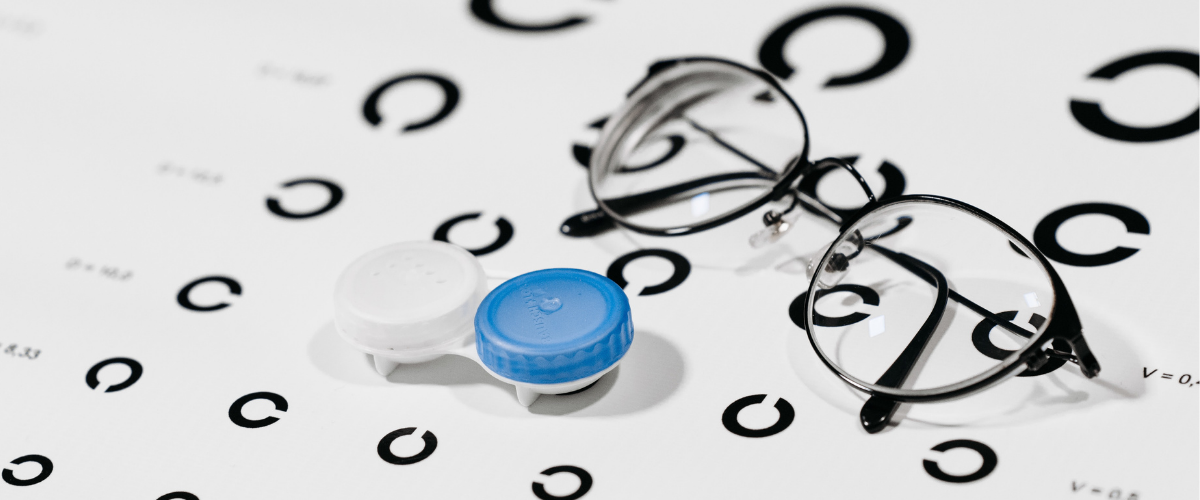
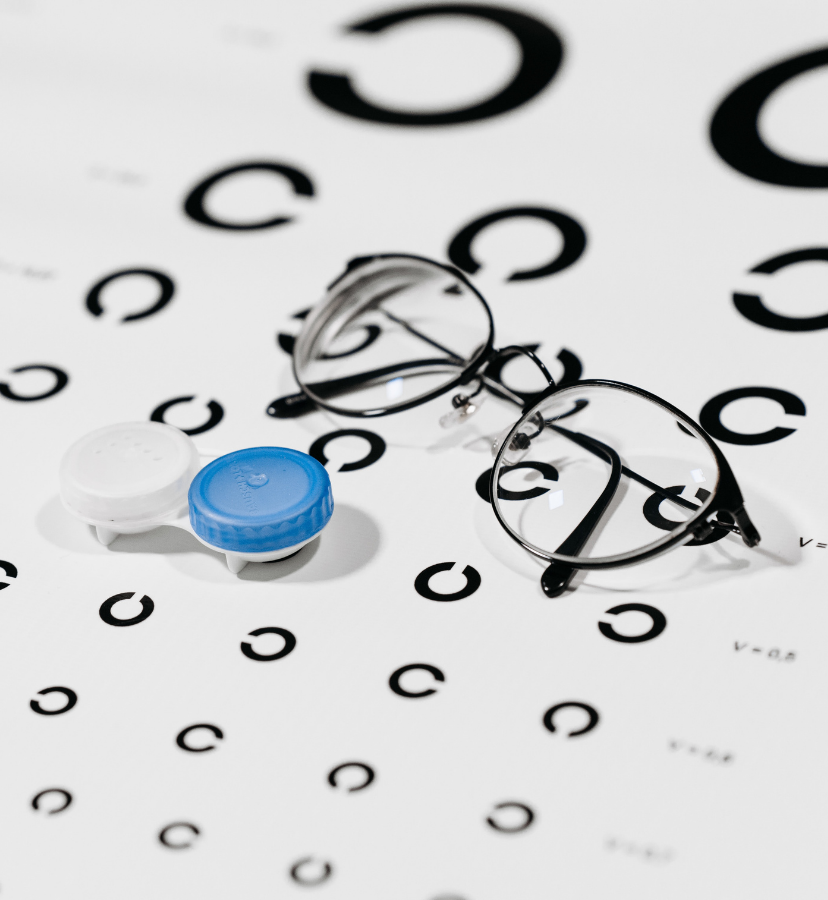
Between the ages of 5 and 13, yearly eye tests are advised, then once every two years from the age of 13 onwards. Your eye doctor will give you a more precise timeframe suited to the vision needs of you or your child, and you should always follow their recommendations.
The presence of myopia and its severity or rate of progression could require more frequent eye tests.
Between the ages of 5 and 13, yearly eye tests are advised, then once every two years from the age of 13 onwards.
Your eye doctor will give you a more precise timeframe suited to the vision needs of you or your child, and you should always follow their recommendations.
The presence of myopia and its severity or rate of progression could require more frequent eye tests.
Protect your eyesight
Some research has been conducted on the link between spending time outdoors and the development of myopia (Xiong et al., 2017). The findings suggest that in children who have not yet developed myopia, spending time outside may help slow its onset. Conversely, it did not prove effective in slowing the progression of myopia in children who already have the condition.
More research is needed to draw concrete conclusions, but spending time out in the open is considered beneficial for myopia and eyesight in general. The increased time we now spend focusing on nearby objects at work or while studying is thought to play a role in the rise in myopia. Being outdoors allows greater opportunities to focus on more distant objects and exercise our eye muscles.
Limiting screen time and doing eye exercises like the 20-20-20 rule (every 20 minutes, focus on an object 20 feet away for 20 seconds) are also recommended. Practice good hygiene with contact lenses and avoid overuse, and wear sunglasses with high UV protection while outdoors. Include the necessary vitamins in your diet for good eye health, and give up smoking.
Follow these guidelines yourself and encourage your children to do the same. If you experience a lack of sharpness in your distance vision and think you – or your child – may have myopia, book an eye test with your local eye doctor. You can also ask one of our opticians if you have any more questions about myopia, other refractive errors, or general eye health.
Some research has been conducted on the link between spending time outdoors and the development of myopia (Xiong et al., 2017).
The findings suggest that in children who have not yet developed myopia, spending time outside may help slow its onset.
Conversely, it did not prove effective in slowing the progression of myopia in children who already have the condition.
More research is needed to draw concrete conclusions, but spending time out in the open is considered beneficial for myopia and eyesight in general.
The increased time we now spend focusing on nearby objects at work or while studying is thought to play a role in the rise in myopia.
Being outdoors allows greater opportunities to focus on more distant objects and exercise our eye muscles.
Limiting screen time and doing eye exercises like the 20-20-20 rule (every 20 minutes, focus on an object 20 feet away for 20 seconds) are also recommended.
Practice good hygiene with contact lenses and avoid overuse, and wear sunglasses with high UV protection while outdoors. Include the necessary vitamins in your diet for good eye health, and give up smoking,
Follow these guidelines yourself and encourage your children to do the same.
If you experience a lack of sharpness in your distance vision and think you – or your child – may have myopia, book an eye test with your local eye doctor.
You can also ask one of our opticians if you have any more questions about myopia, other refractive errors, or general eye health.
References
DK VanderVeen MD (2019), Use of Orthokeratology for the Prevention of Myopic Progression in Children, the American Academy of Ophthalmology. https://pubmed.ncbi.nlm.nih.gov/30476518/
Nouraeinejad, Ali (2021), More Than Fifty Percent of the World Population Will Be Myopic by 2050, Beyoglu Eye Journal. https://www.ncbi.nlm.nih.gov/pmc/articles/PMC8759558/
Xiong et al. (2017), Time spent in outdoor activities in relation to myopia prevention and control: a meta‐analysis and systematic review, Acta Ophthalmologica. https://www.ncbi.nlm.nih.gov/pmc/articles/PMC5599950.
Kaiti et al. (2022), Role of Atropine in the control of Myopia Progression- A Review, Beyoglu Eye Journal.
https://www.ncbi.nlm.nih.gov/pmc/articles/PMC9522992/




































